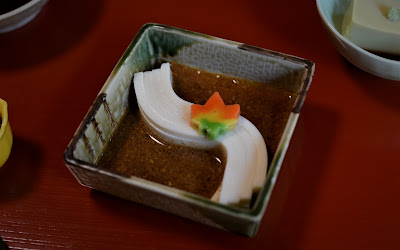
On the second part of the Tsuru-World Kyoto Tour, we visited the Shokoku-Ji Temple (相国寺), formally identified as Mannen-zan Shokoku Shoten Zenji(萬年山相國承天禅寺). This Buddhist temple is also in northern Kyoto and was founded in 1382. Ashikaga Yoshimitsu lived from September 25, 1358 to May 31, 1408) and was the 3rd shōgun of the Ashikaga shogunate. This shogunate was in power from 1368 AD to 1394 AD, and he planned to build a large temple next to the mansion of his shogun family called "Imperial Palace of Flowers". He started building the temple in approx. 1382 AD and in 1392 AD, the project was completed.
This beloved
temple was totally devastated on several occasions from fires and wars with other feuding shoguns/warlords. Because this was such a revered temple, Shokoku-Ji Temple was
rebuilt each time with the assistance and direction of famous Japanese such as: Tokugawa Ieyasu (Founder and 1st shogun of the Tokugawa shogunate) and Toyotomi Hideyoshi, Politician/General, (known as the 2nd "Great Unifier" of Japan).
The grounds surrounding the temple were also destroyed, such as a 109m tall Shichijyudaito (seven-story pagoda). Today, there is a five-story pagoda at To-Ji Temple that is 55m tall. What we think is amazing is that the Japanese people of that era could actually design and build a wooden structure nearly twice the height of the existing five-story pagoda. We were told that people believe that the seven-story pagoda was struck and destroyed by lighting just a few years after its completion. From the buildings on this temple site that remain today, Hatto Hall was constructed in 1605. Most of the other buildings were rebuilt in the 19th Century.
The grounds surrounding the temple were also destroyed, such as a 109m tall Shichijyudaito (seven-story pagoda). Today, there is a five-story pagoda at To-Ji Temple that is 55m tall. What we think is amazing is that the Japanese people of that era could actually design and build a wooden structure nearly twice the height of the existing five-story pagoda. We were told that people believe that the seven-story pagoda was struck and destroyed by lighting just a few years after its completion. From the buildings on this temple site that remain today, Hatto Hall was constructed in 1605. Most of the other buildings were rebuilt in the 19th Century.
The Hatto hall (法堂) has on its slightly domed ceiling a large painting of a dragon “Banryu-zu (Roaring Dragon)”. The painting was done by Kano Mitsunobu (1565–1608 AD). The
dragon symbolizes the rain of Buddhist teachings. When clapping the
hands together, the sound reverberates between the slightly domed
ceiling and the paved stone floor, echoing throughout the hall as if it
was the thunder of the dragon. We love dragons and dragon lore so we found this painting was very special!
 |
| A Preying Mantis also wants to "Pray" at the temple! |
Shokoku-ju Temple's Website:
http://www.shokoku-ji.jp/s_about.html
Next we visited the Mausoleum of the Emperor Hanazono which is located in the Awadaguchi Sanjo-cho, Higashiyama Ward, of Kyoto
City. Emperor Hanazono (1297-1348AD) was the 95th Emperor of the late Kamakura period. Emperor Fushimi was the 3rd prince, and his mother was Riko Fujiwara.

 |
| We enjoyed tofu at Rengetudyaya Tea House in Higashiyama, Kyoto. |
In 1900, the "Rengetudyaya Tea House" was opened as a shop of sweet
sake and hot spring relaxation. many years later, the family decided to offer their special tofu cuisine to their patrons and soon other it became the specialty of this tea house. It is now widely popular among other Japanese people from other prefectures as well as overseas
customers (like us). If you travel near Kyoto you should really think about visiting this very special tea house!
 |
| This tofu was delicious!!!! |
 |
| Their menu |
Rengetudyaya Restaurant's website: https://rengetudyaya.gorp.jp/















































No comments:
Post a Comment